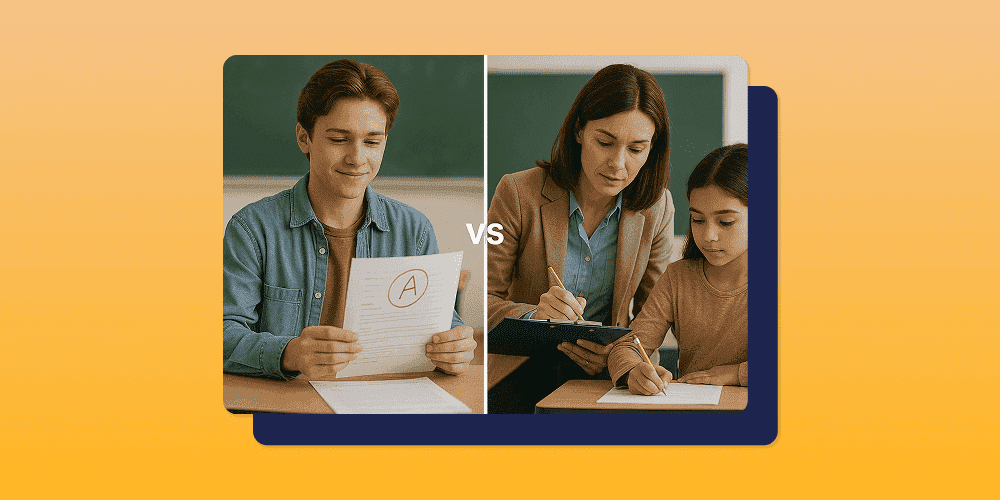
American summer tour! Wooclap will be at InstructureCon 2025
Come say hi at booth 41 from July 22nd to July 24th in Spokane, Washington
7 Practical Examples of Formative Assessments Transforming Learning in 2025
14.05.2025 • 4 minutes

Formative assessments have long been a cornerstone for educators, measuring student understanding levels and how they retain information. However, recently, new technologies and teaching strategies are reshaping how to gather and respond to student progress.
Despite these innovations, many classrooms still rely on traditional methods like homework, quizzes, standardized tests, and final grade exams. These methods, while common, are all examples of summative assessments, a method of evaluating students’ understanding of concepts at the end of a unit or term.
Meanwhile, formative assessments are used during the learning process instead of at the end of it. That’s the key difference between formative and summative assessments; the former helps lecturers understand whether students are learning during lectures and assignments. They also provide ongoing feedback to help improve the teaching process and student performance.
There’s no one-size-fits-all approach to formative assessments.
Like with summative assessments, there are various effective formative assessment examples that can make a huge difference in how students learn. In this article, we will explore each of these examples that will help scale the impact of your lessons and improve student learning outcomes.
Practical Examples of Formative Assessments
The beauty of formative assessment tools is the ability to run them at any point during a lesson. Some work best as icebreakers to activate prior knowledge and support goal setting; others work midway to check and adjust student achievements and understanding levels based on the learning instructions given.
So, here are seven examples of formative assessment that can transform your student learning progress in 2025:
1. Quick Live Poll and Comprehensive Checks
Whether it’s mastering French verb tenses or diving into Earth’s landscapes and countries, a quick poll is one of the simplest and most effective ways to assess your students’ critical thinking and comprehension skills on the spot. It works across subjects and grade levels.

A teaching center guide from Washington University shows that polling is a reliable way to measure student comprehension levels. So, instead of asking “Does everyone understand?”, which often leads to silence or vague nods, polls provide actionable and immediate feedback on any learning gaps that exist. This technique encourages group discussions, group work, and class participation, especially since responses can remain anonymous.
You can conduct quick polls and short quizzes using simple methods like hand-raising or thumbs-up/down gestures. Going digital is also an option, thanks to online tools that support real-time responses. You just have to keep them quick and varied. Examples include true/false, multiple-choice, or even short open-ended responses.
One effective tool for this is Woodclap. With Wooclap, you can launch quick multiple-choice questions to assess comprehension instantly and adapt your teaching accordingly.
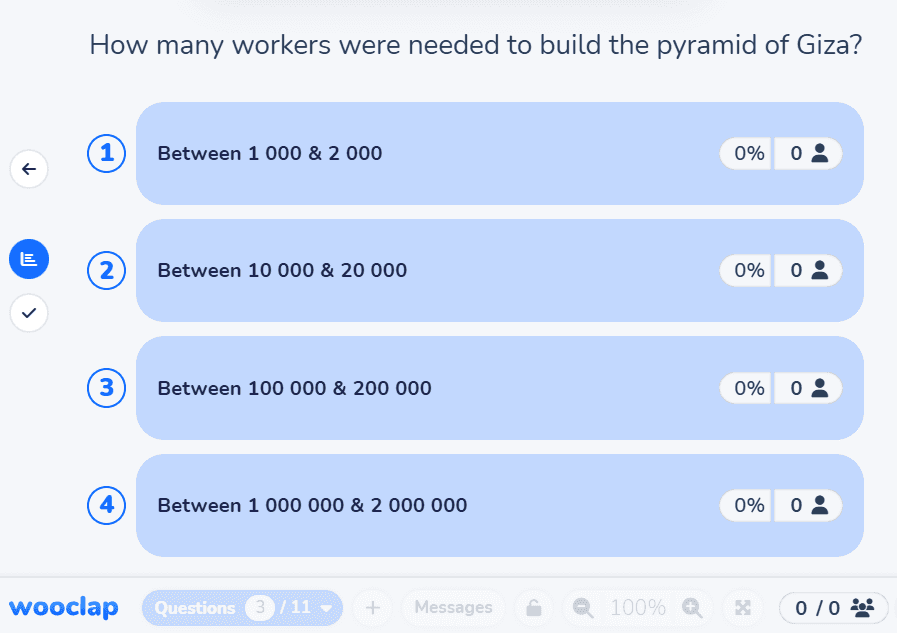
2. Pre-class Questions and Exit Tickets
Okay, so you’ve completed your hour-long lecture, but how do you know your students absorbed the material? Did they retain the key points, or did their minds wander halfway? A short survey in the form of an exit ticket can help clear things up, provide ongoing feedback about the student’s performance levels, and accurately evaluate how things went.
An exit ticket is a brief question or task that students must complete before leaving the classroom. These exit slips are easy to implement on paper or digital devices. Although they come in various formats, the 3-2-1 format is the most common.
This format involves students jotting down:
- 3 things they learned,
- 2 things they found interesting or are curious about, and
- 1 question they might have.
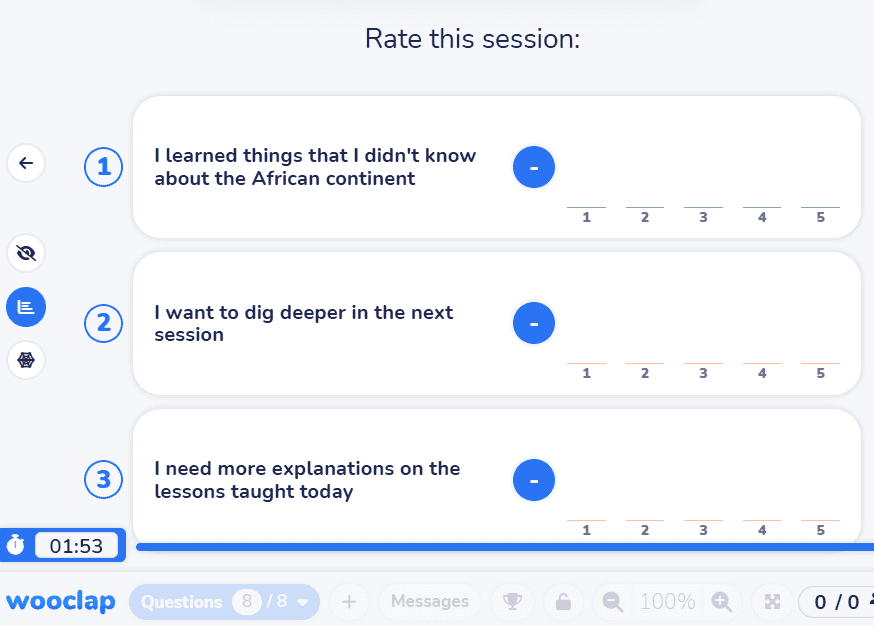
Another interesting prompt is the “Muddiest Point” technique. Here, students can write down the most confusing part of the lesson and get the answers they need. An NIU teaching guide reveals that this technique takes students just a few minutes to complete and gives the teacher a quick overview of any misconceptions.
Tools like Woodclap make it easy to collect student ticket responses digitally. Like quick polls, you can also use multiple-choice or open-ended questions to gather immediate insights into student comprehension.
3. Think-Pair-Share Activities
Sometimes, asking a question in class can result in silence. It’s not that students don’t know the answer; they just need time to process before speaking up. Think-Pair-Share (TPS) is a collaborative strategy that helps students organize their thoughts and engage with their peers through group work.
It’s been used successfully across grade levels and higher education classes for decades. You can conduct a TPS exercise in any classroom, and it can be implemented in as little as five minutes.
According to a 2024 Edutopia article, TPS follows a structured three-step process, including:
- Think: Students think individually about a question or prompt and note their ideas.
- Pair: They collaborate with a partner to discuss their thoughts and compare perspectives.
- Share: Each pair presents their knowledge to the class.
You can use Woodclap’s brainstorming feature to get students to process their ideas together. After each discussion phase, students can quickly submit their key takeaways. This helps you capture their understanding in real-time.

4. Visual Representations for Quick Scales
Asking students to put down answers can be time-consuming — they need time to formulate their ideas and consider how best to word their responses. On your side as a teacher, reviewing these written responses can be just as demanding.
That’s why visual representations like graphic organizers, mind maps, or concept mapping help students share their ideas in a structured and engaging way. You’re also able to see the students’ ability to think and process complex hierarchies.
According to an NIU teaching resource, concept maps allow students to begin with a central idea and branch into related subtopics. You can use visual representations across various topics. For instance:
- In literature, character relationship maps help students analyze narratives.
- In science, students can map food chains, planetary systems, or cell structures.
- In history, maps, timelines, and cause-and-effect diagrams can illustrate the progression of major events.
Woodclap’s concept maps are a great starting point for students to visually share and connect ideas. Additionally, the Word Cloud feature provides an engaging way to surface common themes or check for students’ understanding levels.
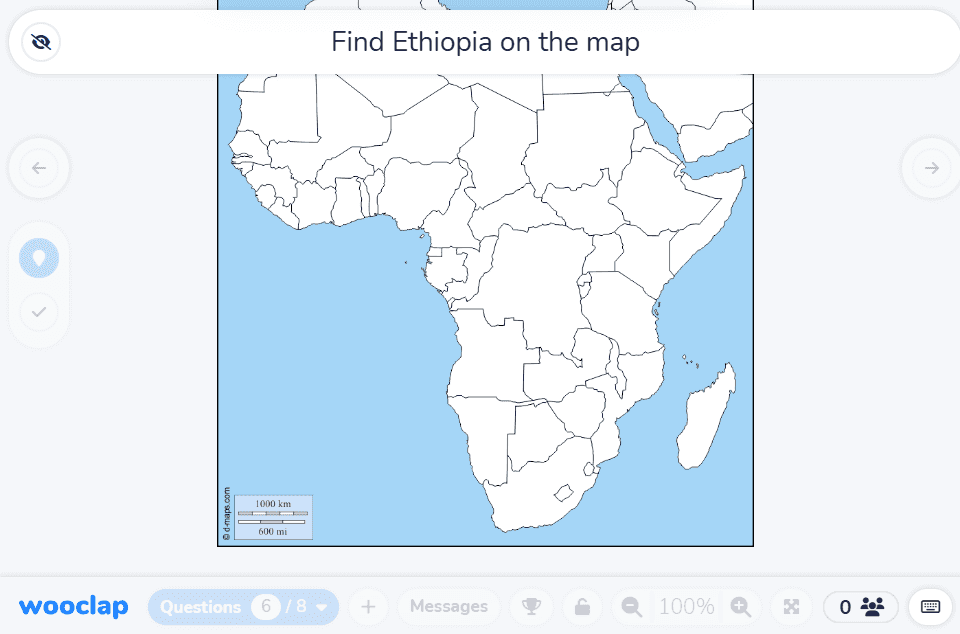
5. One-Minute Papers
Say you just introduced a tricky concept, like a math formula, a historical event, or a literary theme. Instead of pushing ahead or calling on the same few hands, you can introduce a one-minute paper.
One-minute papers require minimal preparation and can be used in any class size and subject. A Northern Illinois University teaching guide shows that this exercise encourages metacognition and allows shy or less vocal students to participate without the pressure of speaking up in class.
Since it’s a brief exercise, your questions should be focused and purposeful. You can ask questions like:
- “What was the main point of today’s class?”
- “How would you summarise today’s class to a friend?”
- “What question do you still have about today’s topic?”
With Woodclap, you can easily digitize the one-minute exercise. Using the Word Cloud feature, students can submit short, focused responses to your questions. Moreover, you can decide to transform these responses into a dynamic visual to further help identify key areas that require more clarity.

6. Peer Critique and Feedback
As a teacher or learning instructor, you don’t have to handle everything by yourself. For instance, instead of reviewing every detail of a student’s work, allow them to assess each other in small groups during class discussions. Cornell University’s Center for Teaching Innovation reveals that peer assessments let students critique and provide constructive feedback on each other’s work.
This diagnostic assessment is mutually beneficial because the reviewer understands more by evaluating someone else’s work. Likewise, the recipient gets new perspectives and improvement tips.
To make this exercise even more productive when conducting classroom assessments, consider a popular structure like “Two Stars and a Wish.” According to a resource by NCME, this structure has each student reviewer identify two things that are done well (stars) and one area that needs further improvement (wish) in their peer’s work. Group discussions like this encourage active learning, student engagement, critical thinking, and real-time feedback.
Woodclap allows you to create active questions and answers for your students to ask themselves. Additionally, students can use the brainstorming feature to share ideas and provide structured and meaningful feedback.
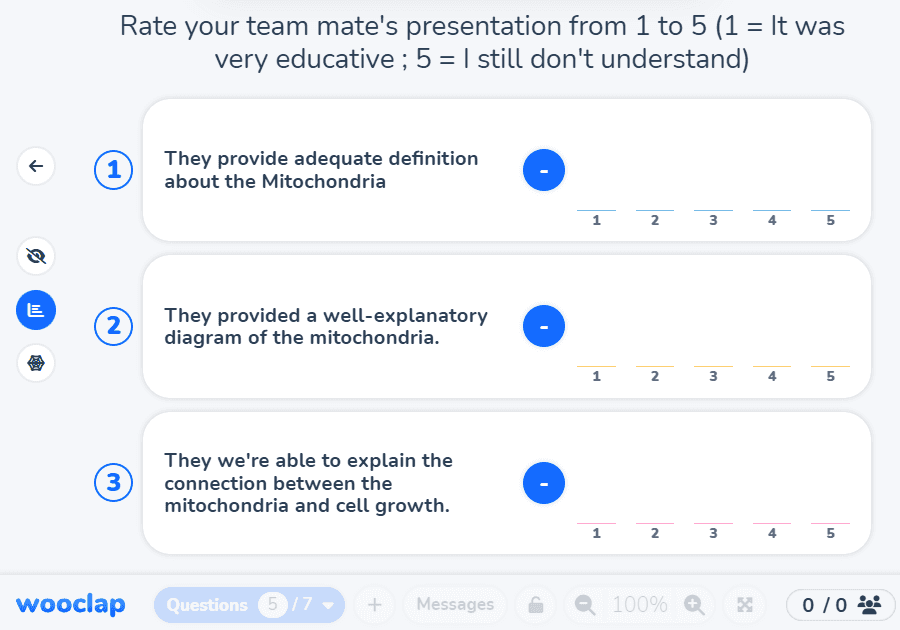
7. Self-Assessment Opportunities
After completing a challenging project, individual students may still be unsure of their understanding of the material or topic. Self-assessments can make them reflect on their learning, identify areas of confusion, and seek a deeper understanding of key concepts that were taught in class.
Self-assessments are a key part of students' building metacognitive skills and creating success criteria for their personal learning goals. Unlike peer assessments, the NCME says that self-assessments help students build self-regulation. This means that your students become aware of goals and make adjustments needed to reach those goals.
More importantly, self-reflections are often kept ungraded and sometimes even private. This allows students to focus on genuine self-improvement rather than writing what they think you just want to see.
You can set up quizzes for students to evaluate themselves using Woodclap’s interactive web quiz. Additionally, integrating numeric confidence scales before and after activities lets students track shifts in their self-perception.

So, what's the next step?
One wonderful part of formative assessment strategies is that these methods continuously monitor student data on comprehension levels. They help you get a clearer picture of how your students’ responses have changed based on your implementations.
All formative assessment processes and classroom discussions differ, and no single diagnostic assessment strategy fits all. However, we hope you have found some useful examples and insights to tailor your lesson plans going forward and gather positive student feedback.
Regardless of your chosen strategy, Woodclap offers interactive and efficient features to bring it to life.
Sign up for the free plan today to start creating interactive lessons and formative assessments.
Writer

The Wooclap team
Make learning awesome & effective
A monthly summary of our product updates and our latest published content, directly in your inbox.



